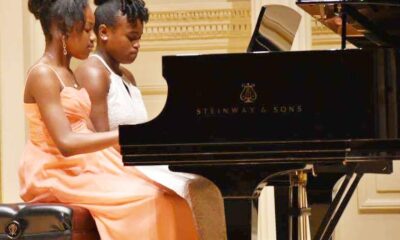Tech News
Clarisa James: DIVAS Creating Youth Changemakers Through Technology

by Fern Gillespie
Black youth using computers is stirring up controversies. On one hand, the Adams administration has filed a lawsuit against the major tech platforms TikTok, Instagram, Facebook, Snapchat, and YouTube for having a damaging influence on the mental health of New York children.
The City’s Health Department states there is a major mental health crisis happening with Black children. On the other hand, this month, Governor Kathy Hochul told a technology panel at a Beverly Hills conference “Right now, we have young black kids growing up in the Bronx who don’t even know what the word ‘computer’ is,” she said. “They don’t know these things.” Of course, she apologized.

For 16 years, Clarisa James and Sha Sha Feng co-founders of DIVAS for Social Justice (Digital Interactive Visual Arts Sciences) have been on the frontline empowering Black youth living in underserved communities in New York City to use tech and visual arts to promote social justice and become change makers in their communities.
From the headquarters on Fulton Street, the nonprofit has empowered youth in Brooklyn, Queens and Manhattan through several innovative STEM and STEAM programs.
Youth have created social action projects through technology training through multi-media, digital media, robotics, coding and 3D Printing.
Our Time Press spoke with Clarisa James, Executive Director, on how DIVAS for Social Justice encourages and trains youth to think critically and provide solutions to problems affecting their communities through technology.
What makes DIVAS for Social Justice unique as a youth STEM program?
We’re showing the youth in our program that they can be the change-maker in their community because they’re actually doing it.
We’re just using the tech as a vehicle toward that goal. STEM or STEAM is not just for people who want to become computer programmers or scientists or engineers or doctors or anything in that realm. STEM is for everyday life. The only way that we’re going to get ahead as a people is that we are equipped with being able to participate in computational thinking and developing 21st-century skills.
Can you discuss the Black Housing Project, a multimedia exhibit that was a collaboration between DIVAS for Social Justice and the Center for New York City Neighborhoods and showcased in Brooklyn, Queens and Manhattan’s Cooper Union?
The Black Housing Project is a 8 to 15-week curriculum that takes youth from ages 8–16 on learning the path to homeownership. We were enriching their literacy skills by writing about what makes a home. Also, looking at what has been the history of housing for communities of color in this country. What we were really doing with that was planting the seed of the importance of inter-generational wealth through housing.
Also, the value of a house versus a home. They laser cut custom houses, and actually within the house displayed QR codes with their voices talking about what makes a house a home. They did the recordings they were sound recordings.
First they wrote the essays. Then they recorded the audio. That was turned into a QR code. That was placed in a little house so when it was on display. It showed that these children are entitled, and have the right to be homeowners and their voice matters in that capacity.”
Did you teach the students how to do a QR code? Why is it important for them to creatively use different tech platforms?
There are platforms that allow you to create a QR code. It was just a matter of taking the content, taking the edited sound of the user’s voice, uploading it to another free platform, that generated a link and using one of the free QR codes. It’s showing them how to take the idea of Web 2.0 and use it to make art.
How do you use it to make a change in your neighborhood? We teach our students how to use WordPress. They write articles on our website and are responsible for uploading those articles. We’re showing them how to use social media for good. To show them these are tools that help build your career and build your portfolio. We provide a platform so the students can understand an analog life.
We work with digital cameras for shooting from an LED screen. My favorite way to introduce students to framing is to take out a Polaroid camera. They’re usually like “What’s that?“ It starts a whole conversation, about understanding the origins of the tech that you’re using now. Technology is always going to be changing at a crazy speed. So, there’s no way that you’re going to be able to know everything. But, you need to be able to have the skills.
What do you think about the emerging popularity of AI?
I think we have a responsibility to show everyone, not just young people, how to use AI in a constructive and critical way. Right now, we are working on how do we use GPT so students can use it in a way that not only teaches them, but serves as a tool.
Do you remind the students to be responsible as users in social media regarding TikTok, Facebook Instagram, etc.?
I try to explain to them what a digital footprint is. Social media never really goes away. You are developing your digital footprint. So who do you want to be 10 years from now or 20 years from now? That digital footprint will follow you. You can decide what that looks like.
What do you think about the whole controversy in terms of social media affecting the mental health of Black children?
We cannot allow social media to raise our children. That’s what’s happening. We have a responsibility to our children and the greater community to say let’s have a conversation about The way that we’re communicating with each other.
One of the things that I’ve noticed with the young people, because they’re so used to staring down at their phones, they have a lot of trouble making eye contact. I’ll tell them it’s important that you make eye contact with people.
I think that there needs to be parameters. I don’t care how many devices, you have you still need that one-on-one connection. That person to person. No device is ever going to replace that.













